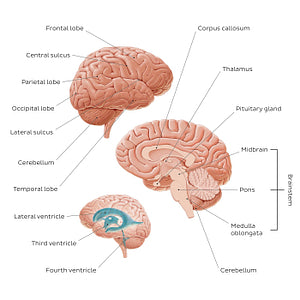Paul Kim
Introduction to the brain (English)
Introduction to the brain (English)
The brain consists of three main parts; cerebrum, cerebellum and brainstem. The cerebrum is organized into two hemispheres that are connected by a large bundle of white matter tissue called the corpus callosum. Each hemisphere of the cerebrum contains five lobes: frontal, temporal, parietal, occipital and insular. The insular lobe is not visible in this image as it is covered by the portions of the parietal, temporal and frontal lobes. These portions together are called operculum, which means “covering” of the insula.The outer surface of the cerebrum exhibits many elevated ridges of tissue called gyri, that are separated by grooves called sulci. The gyri and sulci increase the surface area of the cerebrum, providing it with its characteristic convoluted appearance.The cerebellum is found inferior to the occipital lobe of the cerebrum. It also has two hemispheres that are connected by the vermis.The brainstem is the most caudal part of the brain. It is made up of the midbrain, pons, and medulla oblongata, each of which have their own structural and functional organization.
Regular price
$7.56 USD
Regular price
Sale price
$7.56 USD
Unit price
per
Couldn't load pickup availability


#D56B52
#5998A2
#963522
#5C2A29
#E6A48C
#D6B4A7

